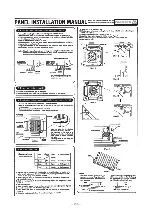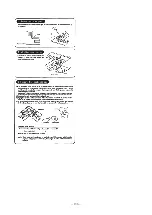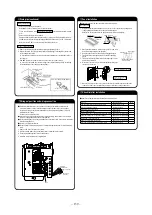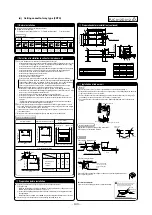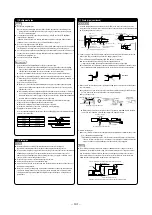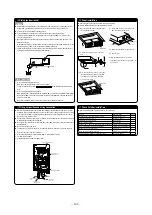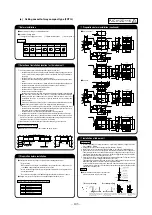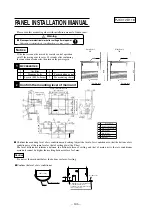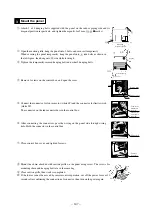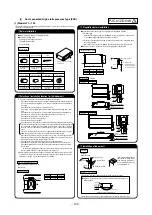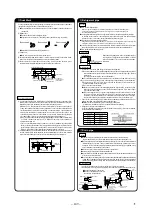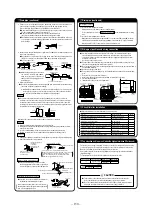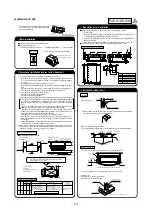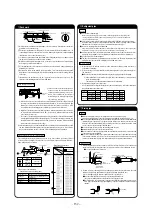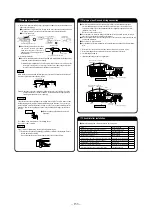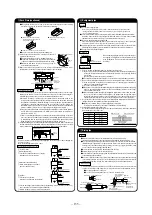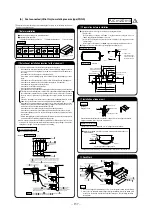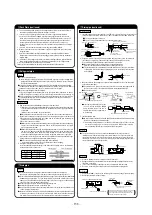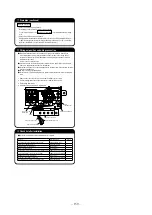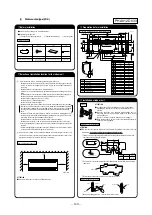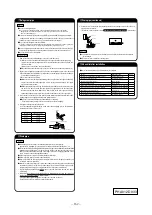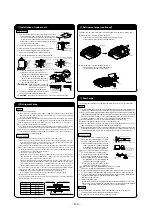
⑤
Duck Work
-
149
*
-
⑥
Refrigerant pipe
⑦
Drain pipe
Caution
●
Use the new refrigerant pipe.
When re-using the existing pipe system for R22 or R407C, pay attention to the following items.
・
Change the flare nuts with the attached ones (JIS category 2), and reprocess the flare parts.
・
Do not use thin-walled pipes.
●
Use phosphorus deoxidized copper alloy seamless pipe (C1220T specified in JIS H3300) for refrigeration pipe installation.
In addition, make sure there is no damage both inside and outside of the pipe, and no harmful
substances such as sulfur, oxide, dust or a contaminant stuck on the pipes.
●
Do not use any refrigerant other than R410A.
Using other refrigerant except R410A (R22 etc.) may degrade inside refrigeration oil. And air getting into
refrigeration circuit may cause over-pressure and resultant it may result in bursting, etc.
●
Store the copper pipes indoors and seal the both end of them until they are brazed in order to avoid any dust, dirt or
water getting into pipe. Otherwise it will cause degradation of refrigeration oil and compressor breakdown, etc.
●
Use special tools for R410 refrigerant.
Piping work
When conducting piping work, make sure to allow the pipes
to be aligned in a straight line for at least 250 mm, as shown
in the left illustration. (This is necessary for the drain pump
to function)
Work procedure
1. Remove the flare nut and blind flanges on the pipe of the indoor unit.
※
Make sure to loosen the flare nut with holding the nut on pipe side with a spanner and giving torque
to the nut with another spanner in order to avoid unexpected stress to the copper pipe, and then
remove them.
(Gas may come out at this time, but it is not abnormal.)
●
Pay attention whether the flare nut pops out. (as the indoor unit is sometimes pressured.)
2.Make a flare on liquid pipe and gas pipe, and connect the refrigeration pipes on the indoor unit.
※
Bend the pipe with as big radius as possible and do not bend the pipe repeatedly. In
addition, do not twist and crush the pipes.
※
Do a flare connection as follows:
●
Make sure to loosen the flare nut with holding the nut on pipe side with a spanner and giving
torque to the nut with another spanner in order to avoid unexpected stress to the copper
pipe, and then remove them.
●
When fastening the flare nut, align the refrigeration pipe with the center of flare nut, screw
the nut for 3-4 times by hand and then tighten it by spanner with the specified torque
mentioned in the table below. Make sure to hold the pipe on the indoor unit securely by a
spanner when tightening the nut in order to avoid unexpected stress on the copper pipe.
3. Cover the flare connection part of the indoor unit with attached insulation material after a gas
leakage inspection, and tighten both ends with attached straps.
●
Make sure to insulate both gas pipes and liquid pipes completely.
※
Incomplete insulation may cause dew condensation or water dropping.
4. Refrigerant is charged in the outdoor unit.
As for the additional refrigerant charge for the indoor unit and piping, refer to the installation
manual attached to the outdoor unit.
Caution
●
Install the drain pipe according to the installation manual in order to drain properly.
Imperfection in draining may cause flood indoors and wetting the household goods
,
etc.
●
Do not put the drain pipe directly into the ditch where toxic gas such as sulfur, the other harmful and
inflammable gas is generated. Toxic gas would flow into the room and it would cause serious
damage to user’s health and safety (some poisoning or deficiency of oxygen). In addition, it may
cause corrosion of heat exchanger and bad smell.
●
Connect the pipe securely to avoid water leakage from the joint.
●
Insulate the pipe properly to avoid condensation drop.
●
Check if the water can flow out properly from both the drain outlet on the indoor unit and the end
of the drain pipe after installation.
●
Make sure to make descending slope of greater than 1/100 and do not make up-down bend and/or trap
in the midway. In addition, do not put air vent on the drain pipe. Check if water is drained out properly
from the pipe during commissioning. Also, keep sufficient space for inspection and maintenance.
Work procedure
1. Insert the supplied drain hose (the end made of soft PVC) to the step of the drain socket on
the indoor unit and fix it securely with the clamp. Attach the hose clamp to the drain hose around 10mm from the end.
●
Do not apply adhesives on this end.
●
Do not use acetone-based adhesives
to connect to the drain socket.
Pipe diameter
Tightening torque N·m
φ
6.35
φ
9.52
φ
12.7
φ
15.88
φ
19.05
14 to 18
34 to 42
49 to 61
68 to 82
100 to 120
Strap (Accessory)
Pipe cover (Accessory)
The thickness of insulation should be 20mm or more.
A corrugated board (for preventing sputtering) is attached to the main body of the air conditioner
(on the outlet port). Do not remove it until connecting the duct.
①●
The air conditioner main unit does not have an air filter. Incorporate it into the easy-to-clean
suction grille.
②
Blowout duct
●
The ducts should be at their minimum lengths.
●
Keep the bends to a minimum. (The bending radius should be as large as possible.)
●
Conduct the duct work before ceiling attachment.
③
Suction duct
●
Make sure to insulate the duct to prevent dewing on it.
④
Location and form of blow outlet should be selected so that air from the outlet will be distrib-
uted all over the room, and equipped with a device to control air volume.
⑤
Make sure provide an inspection hole on the ceiling. It is indispensable to service elecric
equipment, motor, functional components and cleaning of heat exchanger.
①
If a duct is not provided at the suction side but it is substituted with the space over the ceiling,
humidity in the space will increase by the influence of capacity of ventilation fan, strength of
wind blowing against the out door air louver, weather (rainy day) and others.
a)Moisture in air is likely to condense over the external plates of the unit and to drip on the
ceiling. Unit should be operated under the conditions as listed in the above table and within
the limitation of wind volume. When the building is a concrete structure, especially immedi-
ately after the construction, humidity tends to rise even if the space over the ceiling is not
substituted in place of a duct. In such occasion, it is necessary to insulate the entire unit with
glass wool (25mm). (Use a wire net or equivalent to hold the glass wool in place.)
b)It may run out the allowable limit of unit operation (Example: When outdoor air temperature
is 35°C DB, suction air temperature is 27°C WB) and it could result in such troubles as
compressor overload, etc..
c)There is a possibility that the blow air volume may exceed the allowable range of operation
due to the capacity of ventilation fan or strength of wind blowing against external air louver
so that drainage from be heat exchanger may fall to reach the drain pan but leak outside
(Example: drip on to the ceiling) with consequential water leakage in the room.
②
If vibration damping is not conducted between the unit and the duct, and between the unit and
the slab, vibration will be transmitted to the duct and vibration noise may occur. Also, vibration
may be transmitted from the unit to the slab. Vibration damping must be performed.
Air conditioner main unit
Ceiling suriace
Suction hole
(marketed item)
(with air filter)
Inspection hole
Delete
Suction duct
(marketed item)
Blow outlet
Blowout duct
Bad example of duct work
For ventilation
Louver to
outdoor air
Refrigerant pipe
250mm
(Section where attached
in a straight line)
Drain socket
Drain hose
Stage difflernce part
Bad example of duct work
Bad example
Bad example
Good example
Pipe cover (small)
(For insulation) (Accessory)
Pipe cover (For insulation)
(Prepare on site)
Unit
Pipe cover (big)
(For insulation) (Accessory)
VP-20
(Prepare on site)
Joint for VP-20
(Prepare on site)
VP-25
(Prepare on site)
Drain hose
(Accessory)
Drain socket Clamp (Accessory)
(No adhesive allowed)
Fasten the screw securely
Hose clamp
Drain hose
Drain socket
Metal plate
10mm
Summary of Contents for 112KXE6
Page 105: ... 101 Model FDC335KXE6 A PCB003Z035 shows local wining ...
Page 134: ... 130 PJF012D003 ...
Page 135: ... 131 ...
Page 139: ... 135 PJA012D751 b ...
Page 140: ... 136 ...
Page 206: ... 202 2 model type DIS model type HEAD ...
Page 207: ... 203 2 2 ...
Page 208: ... 204 2 2 2 2 2 ...

